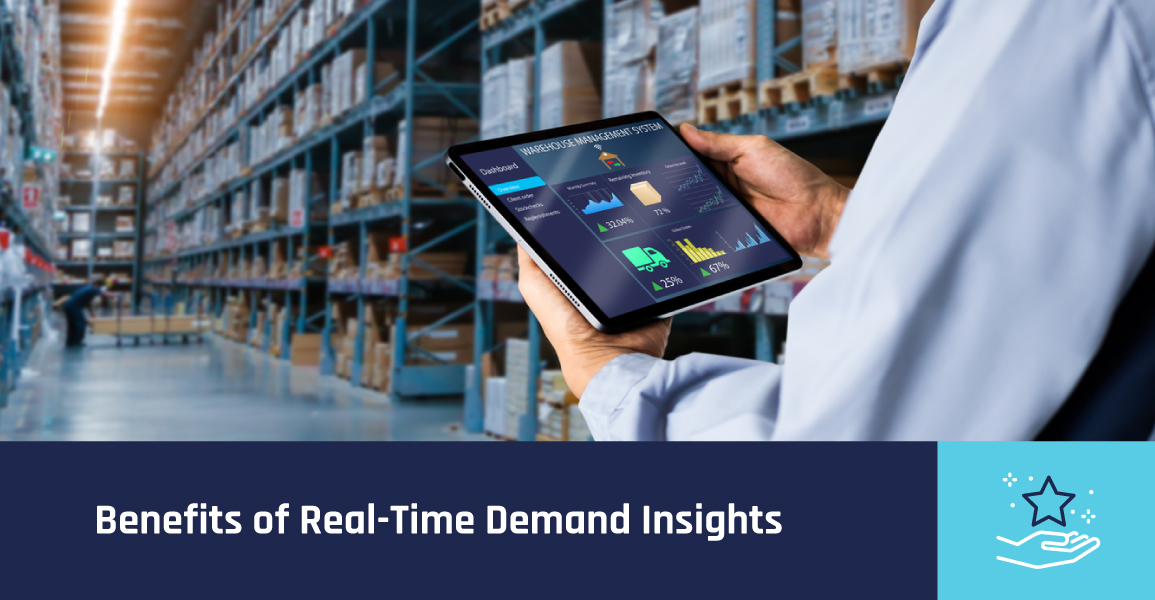
The Power of Proactivity: Leveraging DDMRP for Demand-Driven Excellence
April 22, 2024
Embracing DDMRP: Liberating Your Supply Chain from Conventional Constraints for Unrivalled Agility
May 21, 2024In an ever-evolving business landscape, supply chain resilience is paramount for companies seeking to maintain a competitive edge. Rapid shifts in consumer behaviour, global economic conditions, and unforeseen disruptions necessitate agile and adaptive supply chain strategies. Central to this adaptability is the ability to harness real-time demand insights. This article delves into the significance of leveraging advanced analytics, predictive modelling, and AI-driven technologies to anticipate market dynamics, mitigate risks, and fortify supply chains against uncertainties.
Understanding Market Dynamics
Market dynamics serve as the heartbeat of any industry, pulsating with a complex interplay of forces that shape supply and demand. From the microcosm of individual consumer choices to the macroscopic shifts triggered by global events, these dynamics encapsulate a broad spectrum of influences that impact businesses across sectors.
Consumer Preferences and Purchasing Behaviours
At the nucleus of market dynamics lie the ever-evolving preferences and behaviours of consumers. These preferences are shaped by a multitude of factors, including demographics, lifestyle trends, and cultural influences. Understanding consumer psychology and decision-making processes is paramount for businesses seeking to tailor their products and services to meet evolving demands.
Purchasing behaviours further contribute to the ebb and flow of market dynamics. Factors such as price sensitivity, brand loyalty, and the availability of alternatives can sway consumer choices, exerting a profound impact on supply and demand patterns.
Geopolitical Events and Economic Fluctuations
Beyond the realm of individual consumer actions, market dynamics are also influenced by broader geopolitical events and economic fluctuations. Political instability, trade policies, and regulatory changes can disrupt supply chains, alter market conditions, and reshape consumer sentiment.
Similarly, economic factors such as inflation, interest rates, and unemployment rates exert a significant influence on purchasing power and consumer confidence. Economic downturns can dampen demand for non-essential goods and services, while periods of prosperity may fuel consumer spending and drive up demand.
Informed Decision-Making
Understanding these multifaceted dynamics is indispensable for businesses as they navigate the intricacies of production, distribution, and inventory management. By dissecting and analysing market trends, businesses can make informed decisions regarding product development, pricing strategies, and market positioning.
Moreover, anticipating shifts in demand allows businesses to adjust their supply chains accordingly, mitigating the risk of stockouts or excess inventory. Proactive management of market dynamics enables businesses to seize opportunities, mitigate risks, and maintain a competitive edge in an ever-changing landscape.
The Role of Real-Time Demand Insights
Real time insights offer a window into the dynamic landscape of consumer needs and preferences, empowering businesses to stay ahead of the curve and remain competitive in their respective industries.

Unveiling Consumer Trends and Preferences
Real-time demand insights serve as a powerful tool for unravelling the intricacies of consumer behaviour. By tapping into a myriad of data sources such as point-of-sale transactions, social media interactions, and online searches, businesses can paint a comprehensive picture of evolving consumer trends and preferences. From the latest fashion fads to emerging dietary preferences, real-time demand insights provide businesses with a finger on the pulse of the market, enabling them to adapt their offerings accordingly.
Holistic View of Market Trends
Gone are the days of relying solely on historical data and intuition to drive business decisions. Real-time demand insights offer businesses a panoramic view of market dynamics, encompassing both current trends and future projections. By harnessing the power of advanced analytics and machine learning algorithms, businesses can distil vast amounts of data into actionable insights, identifying patterns, and trends that may have otherwise gone unnoticed.
Aligning Supply Chains with Demand Dynamics
One of the most significant advantages of real-time demand insights lies in their ability to align supply chains with shifting demand dynamics. By accurately forecasting demand patterns and consumer preferences, businesses can optimise their production, distribution, and inventory management processes. This real-time visibility enables organisations to minimise the risk of excess inventory or stockouts, thereby enhancing operational efficiency and reducing costs.
Mitigating Risks and Maximising Opportunities
In a volatile and uncertain market environment, the ability to anticipate and respond swiftly to changing demand is paramount. Real-time demand insights provide businesses with the agility and flexibility needed to mitigate risks and capitalise on emerging opportunities. Whether it’s adjusting production schedules in response to a sudden surge in demand or launching targeted marketing campaigns to capitalise on a new trend, businesses armed with real-time demand insights are better equipped to navigate the ever-changing landscape of the market.
Advanced Analytics and Predictive Modeling
Advanced analytics and predictive modelling emerge as indispensable tools for businesses seeking to thrive in a competitive landscape. These technologies not only unlock the potential of real-time demand insights but also empower organisations to anticipate future trends and make proactive decisions that drive success.

Harnessing Historical Data for Insight
At the heart of advanced analytics and predictive modelling lies the ability to extract valuable insights from historical data. By delving into past trends and patterns, businesses can uncover hidden correlations and identify factors that influence demand fluctuations. Whether it’s analysing sales data from previous quarters or scrutinising consumer behaviour across different demographics, historical data serves as a rich repository of information that fuels predictive analytics.
Leveraging Machine Learning Algorithms
Machine learning algorithms form the backbone of predictive modelling, enabling businesses to sift through vast datasets and extract actionable insights. These algorithms have the capability to detect subtle patterns and trends that human analysts may overlook, thereby enhancing the accuracy and precision of demand forecasts. By continuously learning from new data inputs, machine learning models can adapt and evolve over time, ensuring that predictions remain relevant and reliable in an ever-changing market environment.
Forecasting Demand with Accuracy
The primary objective of advanced analytics and predictive modelling is to forecast demand with greater accuracy and precision. By analysing historical data and identifying key drivers of demand, businesses can develop predictive models that anticipate future fluctuations in consumer behaviour. These models take into account various factors such as seasonality, promotional activities, and external events, enabling organisations to make informed decisions regarding production, inventory management, and resource allocation.
Enabling Proactive Decision-Making
Perhaps the most significant advantage of advanced analytics and predictive modelling is their ability to facilitate proactive decision-making. By providing foresight into future demand trends, these technologies empower businesses to take preemptive action to address potential challenges and capitalise on emerging opportunities. Whether it’s adjusting production schedules to meet anticipated demand or optimising inventory levels to avoid stockouts, proactive decision-making allows organisations to stay ahead of the curve and maintain a competitive edge.
AI-Driven Technologies for Demand Forecasting
Artificial Intelligence (AI) stands as a transformative force in demand forecasting. Through the automation of complex processes and the ability to detect intricate patterns in large datasets, AI technologies are not only reshaping how businesses forecast demand but also how they respond to these predictions in real-time.

Automating and Enhancing Accuracy
One of the core strengths of AI in demand forecasting lies in its capacity for automation. Traditional forecasting methods often require extensive manual effort and are susceptible to human error. AI, on the other hand, automates these processes, thus minimising errors and freeing up human resources for more strategic tasks. Moreover, AI’s capability to process and analyse data from a variety of sources — including transaction records, customer interactions, and external market indicators — at incredible speeds is unparalleled. This rapid analysis ensures that demand predictions are both timely and based on the most current information available.
Streamlining Operations and Enhancing Efficiency
The insights provided by AI-driven demand forecasting empower businesses to streamline their operations. With accurate predictions at their disposal, companies can optimise their inventory levels, ensuring that they have just the right amount of stock to meet anticipated demand without tying up capital in excess inventory. Similarly, production schedules can be adjusted dynamically to align with forecasted demand changes, which enhances overall supply chain efficiency and reduces waste.
Furthermore, these optimizations contribute to a more agile supply chain that can rapidly respond to unexpected changes in the market. By reducing lag times between demand recognition and response, businesses can not only meet customer needs more effectively but also strengthen their competitive advantage in the market.
Benefits of Real-Time Demand Insights
The integration of real-time demand insights into supply chain management confers a multitude of advantages for businesses, ranging from operational efficiency to strategic market positioning. By leveraging the power of data-driven decision-making, organisations can unlock opportunities for growth, mitigate risks, and enhance customer satisfaction.

Improved Inventory Management
Real-time demand insights revolutionise inventory management by providing businesses with a clear understanding of fluctuating demand patterns. By accurately predicting demand fluctuations, organisations can optimise inventory levels to meet customer needs while minimising carrying costs. This optimization reduces the risk of excess or obsolete inventory, freeing up capital that can be reinvested in other areas of the business.
Enhanced Customer Satisfaction
Anticipating and fulfilling customer demand in real-time is paramount for fostering a positive customer experience. By leveraging real-time demand insights, businesses can ensure that they have the right products available when and where customers need them. This leads to higher levels of customer satisfaction, increased loyalty, and positive word-of-mouth referrals, ultimately contributing to long-term business success.
Cost Reduction
Real-time demand insights enable businesses to optimise resource allocation and streamline operations, resulting in significant cost reductions. By aligning production, distribution, and inventory management processes with real-time demand dynamics, organisations can minimise unnecessary expenditures and eliminate waste. This cost-saving measure enhances overall profitability and financial sustainability in an increasingly competitive market environment.
Agility and Adaptability
A supply chain equipped with real-time demand insights is inherently more agile and adaptable to changing market conditions. By continuously monitoring and analysing demand trends in real-time, businesses can respond swiftly to shifts in consumer preferences, emerging market trends, and unexpected disruptions. This agility enables organisations to adjust their strategies, optimise supply chain processes, and seize opportunities as they arise, thereby maintaining a competitive edge in the market.
Competitive Advantage
By leveraging real-time demand insights to stay ahead of market trends and competitors, businesses can gain a distinct competitive advantage. Armed with timely and actionable data, organisations can make informed decisions regarding product development, pricing strategies, and market positioning. This proactive approach enables businesses to capture market share more effectively, expand their customer base, and solidify their position as industry leaders.
Challenges and Considerations
Despite the transformative potential of real-time demand insights, businesses must navigate a series of challenges and considerations to harness these benefits effectively.

Data Quality and Integration
The reliability and accuracy of data are fundamental to the success of real-time demand insights. However, integrating data from disparate sources while ensuring its completeness, consistency, and accuracy poses a significant challenge. Data silos, inconsistencies, and inaccuracies can undermine the effectiveness of demand forecasting efforts, necessitating robust data management strategies and technologies.
Privacy and Security
As businesses collect and analyse vast amounts of consumer data to derive real-time demand insights, concerns about privacy and data security loom large. Safeguarding sensitive information from unauthorised access, breaches, and misuse is paramount to maintaining consumer trust and complying with regulatory requirements. Implementing robust data privacy and security measures is essential to mitigate these risks effectively.
Technology Infrastructure
Implementing AI-driven technologies and advanced analytics requires a robust technology infrastructure and skilled talent. Significant investments in hardware, software, and data infrastructure may be necessary to support real-time data processing, analysis, and insights generation. Moreover, organisations must ensure they have the requisite talent and expertise to leverage these technologies effectively, including data scientists, analysts, and IT professionals.
Organisational Alignment
Achieving alignment across departments and functions is critical to the successful utilisation of real-time demand insights. Siloed data and disparate objectives can hinder collaboration and coordination, leading to inefficiencies and missed opportunities. Establishing clear communication channels, fostering a culture of data-driven decision-making, and breaking down organisational barriers are essential steps to achieving alignment and maximising the value of real-time demand insights.
Ethical Implications
Ethical considerations surrounding data collection, usage, and transparency must be addressed to maintain trust and credibility with customers and stakeholders. Businesses must navigate questions of consent, data ownership, and transparency while ensuring that their use of real-time demand insights complies with legal and ethical standards. Transparency in data collection practices, robust privacy policies, and ethical guidelines for data usage are essential to uphold ethical standards and build trust with consumers.
Conclusion
In an era defined by volatility and uncertainty, building resilient supply chains is imperative for business sustainability and growth. Real-time demand insights, powered by advanced analytics, predictive modelling, and AI-driven technologies, provide businesses with the agility and foresight needed to navigate market dynamics successfully. By embracing these technologies and leveraging data-driven decision-making, organisations can fortify their supply chains, mitigate risks, and thrive in an ever-changing business landscape.
Ready to build a resilient supply chain? Get in touch and unlock the potential of real-time demand insights in your operations.




